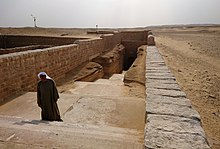Serapeum of Saqqara
 Gate of the Serapeum of Saqqara | |
 Shown within Northeast Africa | |
| Location | Saqqara |
|---|---|
| Coordinates | 29°52′29″N 31°12′45″E / 29.874722°N 31.2125°ECoordinates: 29°52′29″N 31°12′45″E / 29.874722°N 31.2125°E |
| Type | Serapeum |
The Serapeum of Saqqara is a serapeum located north west of the Pyramid of Djoser at Saqqara, a necropolis near Memphis in Lower Egypt. It was a burial place of Apis bulls, sacred bulls that were incarnations of the ancient Egyptian deity Ptah. It was believed that the bulls became immortal after death as Osiris Apis, a name that appears in Coptic as ⲟⲩⲥⲉⲣϩⲁⲡⲓ, Userhapi, which was borrowed in Greek as Σέραπις, Serapis, in the Hellenistic period.
History[]
The most ancient burials found at this site date back to the reign of Amenhotep III, the ninth pharaoh of the Eighteenth Dynasty during the 1350s BC.
Working as an administrator during the reign of his father, Khaemweset, a son of Ramesses II (1279–1213 BC) of the Nineteenth Dynasty, ordered that a tunnel be excavated at the site, and a catacomb of galleries – now known as the "Lesser Vaults" – be designed with side chambers to contain the sarcophagi for the mummified remains of the bulls. But for one, all chambers were found emptied of their contents except for a disarray of dedication stelae.[1][2][3]
A second gallery of chambers, now known as the "Greater Vaults", was excavated under Psamtik I (664–610 BC) of the Twenty-sixth Dynasty and later extended to approximately 350 m in length, 5 m tall and 3 m wide by the Ptolemaic dynasty along with a long, parallel service tunnel. These gallery chambers contained granite and diorite sarcophagi, some weighing up to 70 tonnes (including lid), though all were found empty.[citation needed]
The long boulevard leading to the ceremonial site, flanked by 600 sphinxes, likely was built under Nectanebo I, (379/8–361/0 BC) the founder of the Thirtieth Dynasty (the last native one).
Discovery[]
The temple was discovered by Auguste Mariette,[4] who had gone to Egypt to collect Coptic-language manuscripts, but later grew interested in the remains of the Saqqara necropolis.[5] In 1850, Mariette found the head of one sphinx sticking out of the shifting desert dunes, cleared the sand and followed the boulevard to the site. After using explosives to clear rocks blocking the entrance to the catacomb, he excavated most of the complex.[6] Unfortunately, his notes of the excavation were lost, which has complicated the use of these burials in establishing an Egyptian chronology.
Mariette found one undisturbed burial, which is now at the Agricultural Museum in Cairo. The other 24 sarcophagi of the bulls had been robbed.[citation needed]
Gallery[]

Sphinx of the dromos, now at the Louvre
Detail of a sphinx of the dromos

The crypt of the Louvre

Statue of Apis, from a chapel of the Serapeum (at the Louvre)

The main tunnel in the Serapeum of Saqqara

Sarcophagi in the Serapeum without lid

Serapeum in Saqqara, the sarcophagi with slightly moved cover

One can see the size of sarcophagi
See also[]
| Wikimedia Commons has media related to Serapeum of Saqqara. |
Bibliography[]
- J.-F. Brunet, The XXIInd and XXVth Dynasties Apis Burial Conundrum, Journal of the Ancient Chronology Forum 10 (2005), 26-34.
- Aidan Dodson, Of Bulls & Princes, the early years of the Serapeum at Sakkara, in: KMT 6/1 (1995) 18-32.
- Aidan Dodson, The Eighteenth-Century Discovery of the Serapeum, in: KMT 11/3 (2000) 48-53.
- M. Malinine, G. Posener, J. Vercoutter, Catalogue des Stèles du Sérapéum de Memphis, tome premier (textes), Paris, 1968.
- Auguste Mariette, Le Sérapéum de Memphis, Parijs 1857.
- Auguste Mariette, Catalogue général des monuments d'Abydos découverts pendant les fouilles de cette ville. Paris 1880.
- G. Maspero, Le Sérapeum de Memphis, par Auguste Mariette-Pacha, publié d’après le manuscrit de l’auteur, tome premier. Paris, 1882.
- A. Thijs, The Ramesside Section of the Serapeum, SAK 47, 2018.
Sources and references[]
- ^ Mathieson, I., Bettles, E., Clarke, J., Duhig, C., Ikram, S., Maguire, L., et al. (1997). The National Museums of Scotland Saqqara survey project 1993-1995. Journal of Egyptian archaeology, 83, 17-53.
- ^ Mathieson, I., Bettles, E., Dittmer, J., & Reader, C. (1999). The National Museums of Scotland Saqqara survey project, earth sciences 1990-1998. Journal of Egyptian archaeology, 85, 21-43.
- ^ Dodson, A. "Bull Cults"(2005); Ibrahim, A., Rohl, D. "Apis and the Serapeum"(1988)
- ^ Malek, J. (1983). Who Was the First to Identify the Saqqara Serapeum? Chronique d'Égypte Bruxelles, 58(115-116), 65-72.
- ^ Harry Adès, A Traveller's History of Egypt (Chastleton Travel/Interlink, 2007) ISBN 1-905214-01-4 p. 274.
- ^ Dodson, A. (2000). The Eighteenth Century discovery of the Serapeum. KMT, 11(3), 48-53.
- Egyptology
- Serapeum










